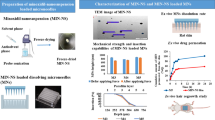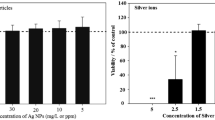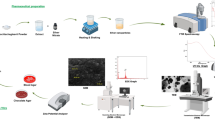Abstract
Purpose
The present work reports a non-conventional therapeutic strategy based on the use of vaginally-applied formulations for the treatment of trichomoniasis due to Trichomonas vaginalis without adding a drug.
Methods
The formulations were based on a thermosensitive pluronic® F127 hydrogel containing mucoadhesive poly(isobutylcyanoacrylate) nanoparticles coated with a mixture of chitosan and thiolated chitosan (75/25 wt%). The nanoparticles were obtained by anionic emulsion polymerization of isobutylcyanoacrylate. The anti-T. vaginalis activity of the formulations was evaluated in vitro.
Results
Chitosan-coated nanoparticles showed a strong anti-T. vaginalis activity at 100 μg/mL independently on the proportion of thiolated chitosan. No anti-T. vaginalis activity was reported neither with chitosan-uncoated poly(isobutylcyanoacrylate) nanoparticles nor with chitosan used as a solution. These results suggest that the anti-T. vaginalis activity was related to poly(isobutylcyanoacrylate) nanoparticles but only when they are coated with chitosan. Histological analysis of ex vivo pig vaginal mucosa in contact with pluronic® F127 hydrogel containing poly(isobutylcyanoacrylate) nanoparticles coated with the mixture chitosan/thiolated chitosan (75/25 wt%) did not reveal any toxicity.
Conclusion
This study demonstrated that poly(isobutylcyanoacrylate) nanoparticles coated with chitosan were active against T. vaginalis without adding a drug. Besides their anti-T. vaginalis activity, the formulations are non-toxic towards pig vaginal mucosa.





Similar content being viewed by others
Abbreviations
- HIV:
-
Human immunodeficiency virus
- IBCA:
-
Isobutylcyanoacrylate
- MTZ:
-
Metronidazole
- Np:
-
Nanoparticle
- PBS:
-
Phosphate buffer saline
- PIBCA:
-
Poly(isobutylcyanoacrylate)
- SVF:
-
Simulated vaginal fluid
- TBA:
-
Thiol-butylamidine
- TYM:
-
Trypticase-yeast extract-maltose
References
Cotch MF, Pastorek JG, Nugent RP, Hillier SL, Gibbs RS, Martin DH, et al. Trichomonas vaginalis associated with low birth weight and preterm delivery. The vaginal infections and prematurity study group. Sex Transm Dis. 1997;24(6):353–60.
Hardy P, Nell EE, Spence M, Hardy J, Graham D, Rosenbaum R. Prevalence of six sexually transmitted disease agents among pregnant inner-city adolescents and pregnancy outcome. Lancet. 1984;324(8398):333–7.
Minkoff H, Grunebaum AN, Schwarz RH, Feldman J, Cummings M, Crombleholme W, et al. Risk factors for prematurity and premature rupture of membranes: a prospective study of the vaginal flora in pregnancy. Am J Obstet Gynecol. 1984;150(8):965–72.
Laga M, Nzila N, Goeman J. The interrelationship of sexually transmitted diseases and HIV infection: implications for the control of both epidemics in Africa. AIDS. 1991;5:S55–63.
Lomax NJ, Estcourt C, Mirakian R. Symptomatic trichomoniasis, metronidazole allergic and pregnant-a management dilemma. Int J STD AIDS. 2004;15:275–6.
Cudmore SL, Delgaty KL, Hayward-McClelland SF, Petrin DP, Garber GE. Treatment of infections caused by metronidazole-resistant Trichomonas vaginalis. Clin Microbiol Rev. 2004;17:783–93.
Conner TH, Stoeckel M, Evrard J, Legator MS. The contribution of metronidazole and two metabolites to the mutagenic activity detected in the urine in treated humans and mice. Cancer Res. 1977;37:629–33.
Lindmark DG, Muller M. Antitrichomonad action, mutagenicity, and reduction of metronidazole and other nitroimidazoles. Antimicrob Agents Chemother. 1976;10:476–82.
Bravo-Osuna I, Vauthier C, Farabollini A, Palmieri G-F, Ponchel G. Mucoadhesion mechanism of chitosan and thiolated chitosan poly(isobutylcyanoacrylate) core-shell nanoparticles. Biomaterials. 2007;28:2233–43.
Petit B, Bouchemal K, Vauthier C, Djabourov M, Ponchel G. The counterbalanced effect of size and surface properties of chitosan-coated poly(isobutylcyanoacrylate) nanoparticle on mucoadhesion due to pluronic F68 addition. Pharm Res. 2012;29:943–52.
Mazzaferro S, Bouchemal K, Skanji R, Gueutin C, Chacun H, Ponchel G. Intestinal permeation enhancement of docetaxel encapsulated into methyl-b-cyclodextrin/poly(isobutylcyanoacrylate) nanoparticles coated with thiolated chitosan. J Control Release. 2012;162:568–74.
Owen DH, Katz DF. A vaginal fluid stimulant. Contraception. 1999;59:91–5.
Bernkop-Schnürch A, Hornof M, Zoidl T. Thiolated polymers-thiomers: synthesis and in vitro evaluation of chitosan-2-iminothiolane conjugates. Int J Pharm. 2003;260(2):229–37.
Bravo-Osuna I, Schmitz T, Bernkop-Schnürch A, Vauthier C, Ponchel G. Elaboration and characterization of thiolated chitosan-coated acrylic nanoparticles. Int J Pharm. 2006;316(1–2):170–5.
Bouchemal K, Agnely F, Koffi A, Ponchel G. A concise analysis of the effect of temperature and propanediol-1,2 on pluronic F127 micellization using isothermal titration microcalorimetry. J Colloid Interface Sci. 2009;338:169–76.
Aka-Any-Grah A, Bouchemal K, Koffi A, Agnely F, Zhang M, Djabourov M, et al. Formulation of mucoadhesive vaginal hydrogels insensitive to dilution with vaginal fluids. Eur J Pharm Biopharm. 2010;76(2):296–303.
Zhang M, Djabourov M, Bourgaux C, Bouchemal K. Nanostructured fluids from pluronic mixtures. Int J Pharm. 2013;454(2):599–610.
Diamond LS. The establishment of various trichomonads of animals and man in axenic cultures. J Parasitol. 1957;43(4):488–90.
Camuzat-Dedenis B, Provot O, Cointeaux L, Perroux V, Berrien J-F, Bories C, et al. Synthesis and in vitro anti-Trichomonas activities of some new dialkylperoxides and 1,2,4-trioxanes. Eur J Med Chem. 2001;36(10):837–42.
Squier CA, Mantz MJ, Schlievert PM, Davis CC. Porcine vagina ex vivo as a model for studying permeability and pathogenesis in mucosa. J Pharm Sci-US. 2008;97(1):9–21.
Mazzaferro S, Bouchemal K, Vauthier C, Gueutin C, Palmieri G-F, Ponchel G. What are parameters affecting Leu-enkephalin loading and release from poly(isobutylcyanoacrylate) nanoparticles coated with thiolated chitosan? J Drug Del Sci Tech. 2011;21(5):385–93.
Couvreur P. Polyaklylcyanoacrylates as colloidal drug carrier. CRC Crit Rev Ther Drug Carrier Syst. 1988;5:1–20.
Costa e Silva Filho F, Elias CA, de Souza W. Further studies on the surface charge of various strains of Trichomonas vaginalis and Trichomonas foetus. Cell Biophys. 1986;8(3):161–76.
Bernkop-Schnürch A, Kast CE, Guggi D. Permeation enhancing polymers in oral delivery of hydrophilic macromolecules: thiomer/GSH systems. J Control Release. 2003;93:95–103.
Quraishi MS, Jones NS, Mason J. The rheology of nasal mucus: a review. Clin Otolaryngol Allied Sci. 1998;23:403–13.
Samet JM, Cheng PW. The role of airway mucus in pulmonary toxicology. Environ Health Perspect. 1994;102:89–103.
Chao C-CW, Vergnes J-P, Brown SI. Fractionation and partial characterization of macromolecular components from human ocular mucus. Exp Eye Res. 1983;36:139–50.
Engel E, Guth PH, Nishizaki Y, Kaunitz JD. Barrier function of the gastric mucus gel. Am J Physiol Gastrointest Liver Physiol. 1995;269:G994–9.
Gipson IK. Mucins of the human endocervix. Front Biosci J Virtual Libr. 2001;6:1245–55.
van Eyk A, van der Bijl P. Porcine vaginal mucosa as an in vitro permeability model for human vaginal mucosa. Int J Pharm. 2005;305:105–11.
Mazzaferro S, Bouchemal K, Maksimenko A, Skanji R, Opolon P, Ponchel G. Reduced intestinal toxicity of docetaxel into mucoadhesive nanoparticles, in mouse xenograft model. J Colloid Sci Biotechnol. 2012;1:210–7.
ACKNOWLEDGMENTS AND DISCLOSURES
This work was supported by grants from Région Ile de France.
Author information
Authors and Affiliations
Corresponding author
Rights and permissions
About this article
Cite this article
Pradines, B., Bories, C., Vauthier, C. et al. Drug-Free Chitosan Coated Poly(isobutylcyanoacrylate) Nanoparticles Are Active Against Trichomonas vaginalis and Non-Toxic Towards Pig Vaginal Mucosa. Pharm Res 32, 1229–1236 (2015). https://doi.org/10.1007/s11095-014-1528-7
Received:
Accepted:
Published:
Issue Date:
DOI: https://doi.org/10.1007/s11095-014-1528-7




